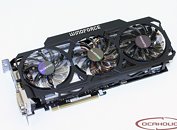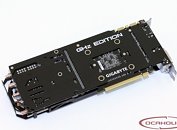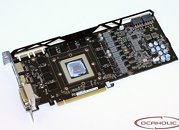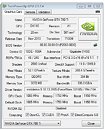Wednesday, December 4th 2013

Gigabyte GeForce GTX 780 Ti GHz Edition Detailed
Gigabyte, which gave the GeForce GTX 780 the "GHz Edition" treatment, in which the GPU core is factory-overclocked above the 1 GHz mark, meted out the same with the more powerful GTX 780 Ti. Positioned above the GTX 780 Ti OC Edition which debuted early last month, the GHz Edition features a swanky new custom-design PCB by Gigabyte, which features a strong VRM; coupled with the same WindForce 450W cooling solution that's featured on the GTX 780 GHz Edition. The GTX 780 Ti OC Edition, on the other hand, is a combination of the WindForce 450W cooler and NVIDIA reference PCB, with a factory-overclock.
The PCB of Gigabyte GTX 780 Ti GHz Edition is a bustling metropolis, with a 10+2 phase VRM that draws power from a pair of 8-pin PCIe power connectors. The cooler, on the other hand, is a complex aluminium fin-stack heatsink to which heat is fed by five 8 mm-thick copper heat pipes, and which are ventilated by a trio of 100 mm fans.The large heatsink is supported by a base plate that draws heat from the memory and VRM; a support brace that runs along the top of the card, and a back-plate. Gigabyte tuned the card with clock speeds of 1085 MHz core (base), 1150 MHz core (GPU Boost), and a surprisingly untouched 7.00 GHz (GDDR5-effective) memory. Based on the 28 nm GK110 silicon, the GTX 780 Ti features 2,880 CUDA cores, 240 TMUs, 48 ROPs, and a 384-bit wide GDDR5 memory interface, holding 3 GB of memory. There's no word on when Gigabyte will formally launch this card. It shouldn't be too far away.
Source:
OCaholic.ch
The PCB of Gigabyte GTX 780 Ti GHz Edition is a bustling metropolis, with a 10+2 phase VRM that draws power from a pair of 8-pin PCIe power connectors. The cooler, on the other hand, is a complex aluminium fin-stack heatsink to which heat is fed by five 8 mm-thick copper heat pipes, and which are ventilated by a trio of 100 mm fans.The large heatsink is supported by a base plate that draws heat from the memory and VRM; a support brace that runs along the top of the card, and a back-plate. Gigabyte tuned the card with clock speeds of 1085 MHz core (base), 1150 MHz core (GPU Boost), and a surprisingly untouched 7.00 GHz (GDDR5-effective) memory. Based on the 28 nm GK110 silicon, the GTX 780 Ti features 2,880 CUDA cores, 240 TMUs, 48 ROPs, and a 384-bit wide GDDR5 memory interface, holding 3 GB of memory. There's no word on when Gigabyte will formally launch this card. It shouldn't be too far away.




23 Comments on Gigabyte GeForce GTX 780 Ti GHz Edition Detailed
AMA
An EVGA rep confirmed this, by the way.
EVGA have already announced a 6Gb version of the 780ti (the kingpin edition) for the end of december. And other partner manufacturers like Asus, Msi etc. Shouldn't be that far behind. There is no logical reason for NVIDIA not to allow partners to increase the memory. The Titan will still sell in limited numbers as it is superior in double precision calculations, so there are buyers outside the gaming community. Obviously titan production is reduced as most Kepler chips will be used for 780ti. And it will slowly be phased out. NVIDIA won't have a problem with products remaining on the shelves and not being sold, but to claim they won't allow partners to increase memory on their flagship card is ridiculous, they are always aiming to keep the leading edge over Amd, so with the 4Gb memory on radeon R9x/R9 and amd mantle on the way the increase of memory by NVIDIA is not just logical but probably encouraged by NVIDIA itself. High end cards are hardly the products NVIDIA or amd make their main profit, not even close but to keep the performance edge in the top cards is very important PR that affects sale numbers of the low and most importantly the middle segment cards which are the products that sell in huge quantities and make the most amount of profit.
You guys keep forgetting that NVIDIA does whatever it wants with its AIBs, they are being kept on a leash.
Don't you think that if they could release a 6gb 780Ti they would already have released it?
All it takes is just soldering extra vram chips to pre existing traces.
forums.hardwarezone.com.sg/hardware-clinic-2/evga-geforce-gtx-780ti-classified-kingpin-edition-6gb-ddr5-4486178.html
Also reliable tech websites have reported on it, why would EVGA make the announcement if NVIDIA wouldn't allow it.?
What most people fail to understand is that a 6Gb 780ti won't affect Titan sales. Sure Titan sales was reduced significantly after 780ti was introduced for obvious reasons, but the vast majority of those gamers that would buy a 6Gb 780ti over titan would buy a 3Gb 780ti over Titan anyways if a 6Gb version didn't exist. So overall it won't make any big difference for NVIDIA. The difference a 6 Gb version would make on the other hand is to attract those undecided buyers that are considering Radeon R9X/R9 because of the 1 Gb extra memory. Multiple screen and high res screen users are just increasing day by day and with the more and more demanding upcoming games VRAM size is an important issue. The reduction in Titan sales has already been compensated by lowered production rates as the production facilities are concentrating their capabilities to increased 780ti output for obvious reasons. Those titans they produce or in stock will find themselves to buyers as those people buy the Titan for its DP capability which outperforms 780ti everyday of the week. Why else do you think that the Price of the Titan card has not seen any significant reduction. At least not here in Sweden where I live. If they were the least worried they would campaign and reduce the price.
780ti gives up that extra buffer in exchange for the higher-speed ram and clock potential. Be it up to 103xMhz for the 7ghz stock clock, or somewhere around 1170Mhz/7900 if you figure absolute performance potential.
This product exploits the fact the product is binned to allow that core potential, while also showing it is painfully obvious nvidia does not allow an overclocked memory clock out-of-the-box. I would not be surprised if the memory is binned to ~7800mhz though for that 1150mhz clock.
These realities are why it will be interesting if 290x can be binned/overclocked by aibs to be proportional. 1150/7800 would be more or less similar to a 290x at some where around 1175/5800 to 1210/6000...but is that realistic with the extra memory and the power penalties of voltage/power needed for clocks more than 5ghz to slightly over?
It's all a balancing act...but in truth they are very, very close. 290x is more efficient arch speaking, but the ram in this case could be perceived as a detriment for the design as opposed to what nvidia did with 3gb (granted using more power on faster ram).
I bought two of them instead of buying a Quadro that costs 3x as much, especially because I don't need Quadro level driver support for what I do.
But, while the Titan is a boon to people like me it would have never made a noticeable selling volume without people that bought it for gaming.
www.legitreviews.com/evga-geforce-gtx-780-ti-kingpin-6gb-video-card-made-overclocking_130114
Nvidia Bus and vRAM count is not completely tied together like AMDs cards.
For instance, the GTX660s have 192 bit bus, and with both 2GB and 3GB vRAM capacities.
Cards these days aren't powerful enough to run 4k resolutions at a playable frame rate unless you have 2 or more cards anyways, and not to mention 4k is just now starting to hit the market it decent volumes, but crazy high prices. 20nm cards will be where its at and beyond if you want to play at 4k.
Its not quite like that, true that the it all has to be all down to symmetry of the memory banks and the ROPS, one ROP partition requires one memory controler but in regards to the 660, Nvidia uses tricks to to be able to use 4 x 512k on just three 64 bit memory controllers one for each ROP, so what the do is double up on one controller, in order to make the 2 gig of Vram, tho downside is the lack of bandwidth, but on a mid range card this is not to much of a problem but could be in SLI and max settings depending on the game also, AMD dont do this because the either dont have the know how, or its just more efficient for them to stick to the symmetry i dont really know, there must also be limitations with the size of memory modules used as the all seem to be 256 in size, so on a 2 gig card you would have 8 of these on the one side of the card, and both sides on a 4 gig card, and the seem to be paired up